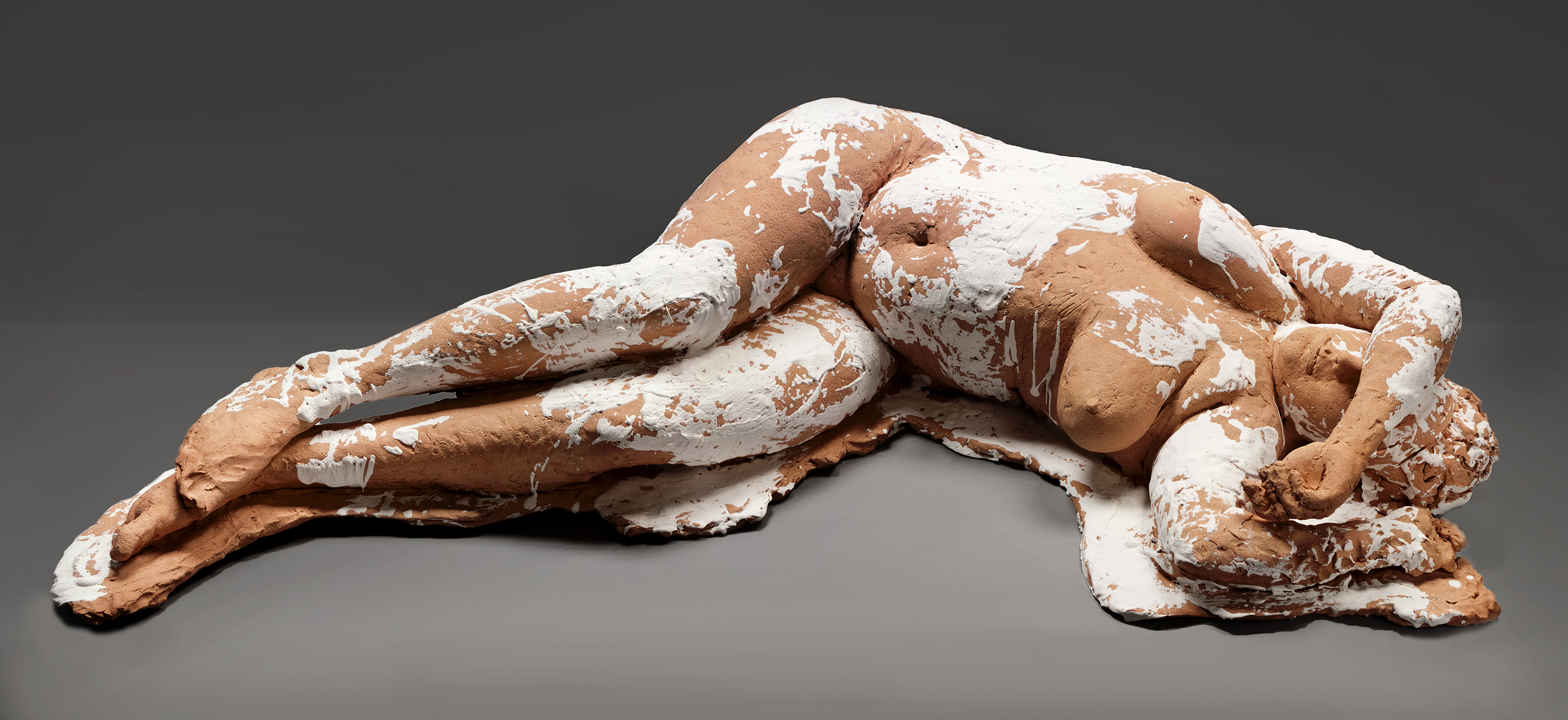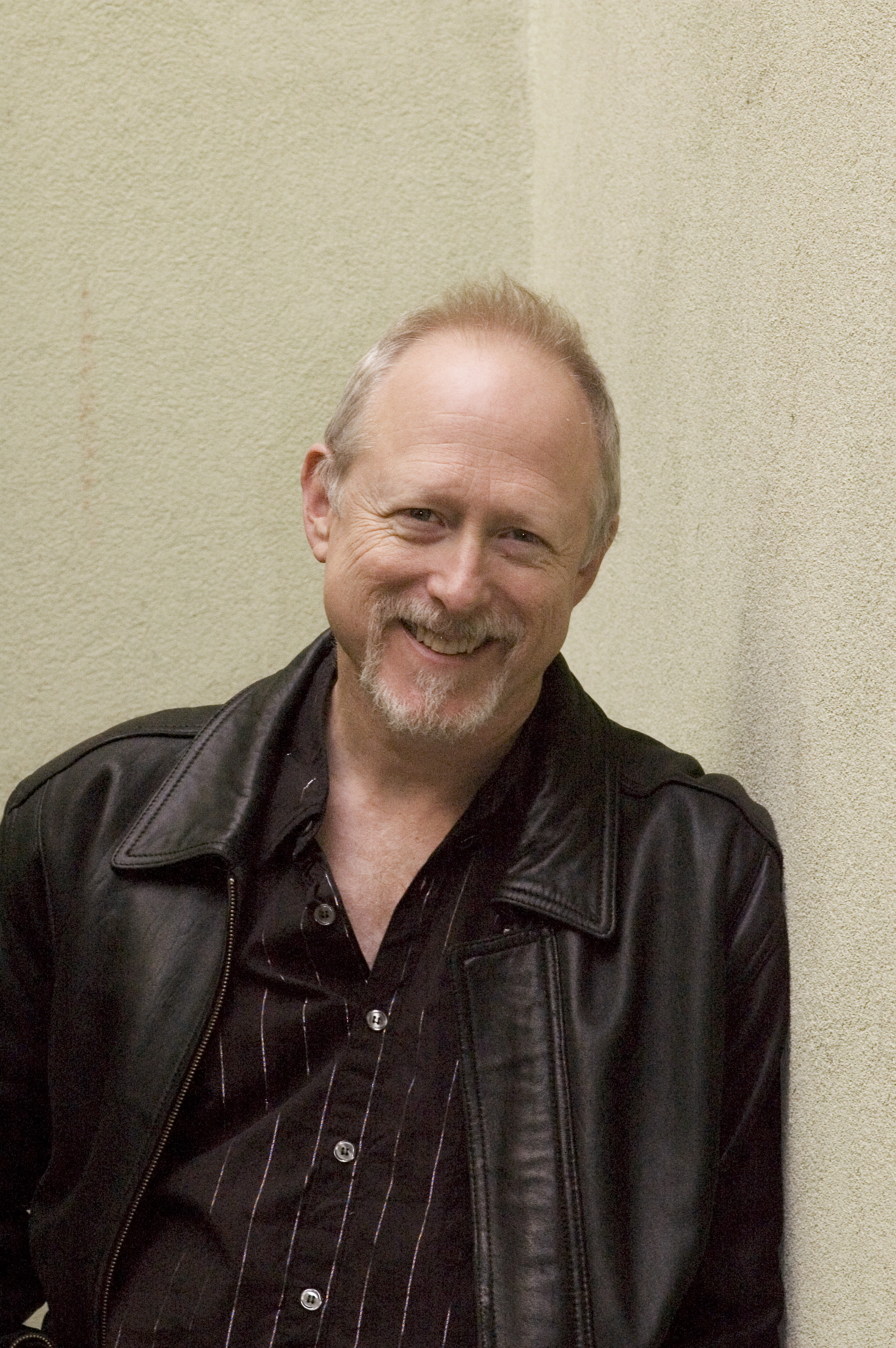“The past and the present are always in flux for me,” says Canadian sculptor Kathy Venter as she leads a small tour through the large mottled clay figures that populate LIFE. With more than 30 pieces on view at Bellevue Arts Museum through June 15, this traveling show has the familiarity of folks you might meet on the bus or in line at the supermarket; the forms and faces are ordinary, not like polished marble gods on museum pedestals. Only the textures feel ancient. The figures, most of them nude women, aren’t glazed or smoothed to perfection in the kiln. Often splashed with paint, they look like something found at an archeology dig. (Crumbling Corinthian columns flank one piece, as if framing a stage set.)
Venter uses traditional terracotta methods and materials in a process that can take months, modeling her figures not from drawings or photographs, but from life. She finds her non-professional, unglamorous models in Salt Spring Island, B.C., where the South Africa native has lived for over two decades. Venter cites both Greek statuary and Xhosa tribal rituals among her influences, and the daubs of paint, which add color to her reddish figures, recall National Geographic images of African dance ceremonies. And even if Venter resists traditional poses (some figures are simply slumped on the ground), she originally trained as a dancer, which gives her an intimate familiarity with the body’s workings and postures.
A sense of ritual attends the groupings here. One cluster of women, called Coup d’Oeil, is poised in loose formation. Arms relaxed, palms open, they’re not exactly supplicating or worshipping; and they’re certainly past the age of any initiation ceremony. Life-size, like most of Venter’s work, they have a certain frumpy dignity, a fleshy pragmatism that sets them apart from anyone’s ideal—be it classical, Vogue, or America’s Next Top Model. You don’t have to be an Amazon or supermodel to show strength.
Flopped down on the floor are an infant and mother. Says Venter of the new mom, “She’s got an almost bovine contentment.” This is what the post-partum body looks like, she explains, and that’s why she asked this ordinary Canadian to model for her. (No male figures are included in the show; Venter admits it’s harder to get her male neighbors to strip for her scrutiny.) And again, this is what actual feminine power looks like: the effort and exhaustion necessary to push new life into the world, and the relief that comes after.
Venter depicts what the Greeks and most (male) Western sculptors who came later did not: the actual, rather than idealized, female form. “Everything is written there,” she says of these figures. In their physical attitudes and Venter’s descriptions, as she walks among them, there’s the easy rapport of a women’s bath or sauna. Rustic strangers to us, these are people she knows and clearly respects—not just representations.
Dan Webb is also having his first solo show at BAM. The local artist trained at Cornish, though he didn’t start out to be a woodworker. One early work in Fragile Fortress, also on view through June 15, is actually a medieval suit of armor constructed with silvery duct tape. He’s not apologizing for the humble pine, Douglas fir, maple, and cedar, but emphasizing the contrast between grainy source and emergent form.
“Everything is temporary,” says Webb as he discusses his work. In a piece called Woodylion, a dandelion sprouts through a big block of redwood, its root penetrating the pedestal. It’s all hewn from the same material, of course, but we see here the contrast between life cycles long and short, a juxtaposition of past and present. Wood contains its own story, says Webb. In all those tree rings and imperfections lie decades and even centuries of history. Much of his material comes from salvaged old-growth timber originally milled during Seattle’s first building boom in the late 19th century—all the structures being torn down for new South Lake Union high-rises. Northwest history is now being written on a far more accelerated scale than that of tree rings.
In Splash, a watery explosion seems to erupt from a block of fir, as if a pebble has been dropped onto its surface. The concentric tree rings again denote time being measured on different scales: instant and ancient. Nearby, a wooden birthday-party balloon appears to float—another ephemeral thing actually made to last. Here and elsewhere, like the impression of an absent sleeper’s head on a pillow, there’s a quality of imposed duration, of time suspended.
In these selections, made from Webb’s last 15 years of work, are visual puns and explicit references to the nature of woodcarving. On the human limbs that emerge—like tree limbs—from a fir slab are hands holding the mallet and chisel of Webb’s trade. He often only carves portions of his source material, to contrast the finished and raw states. He’s adding something to the wood, but “I’m also a destroyer,” he says. Indicating the cut marks, old nail holes, and traces of the sawmill, he notes, “It is very much a creative destruction.”
Also on view are two ongoing group shows worth seeing. At Your Service
(through September 21) features 10 national artists using dining plates for anything but their intended purpose. These familiar domestic tokens are drilled out to make jewelry, massed on the wall to form a mural, and cheekily modified by Niki Johnson, in one instance, to erase all the churches out of an ecclesiastical set of commemorative china.
Traveling from the Arizona State University Art Museum is Crafting a Continuum: Rethinking Contemporary Craft
(through April 27), a collection of some 60 diverse and eclectic objects. The works here range from porcelain bunnies to hand-embroidered comic books to a bicycle enveloped with osier (a natural fiber akin to rattan). It’s like a yard sale where nothing’s on sale, like those plates you can’t use for dining.
bmiller@seattleweekly.com
BELLEVUE ARTS MUSEUM 510 Bellevue Way N.E., 425-519-0770, bellevuearts.org. $8–$10. 11 a.m.–6 p.m. Tues.–Sun.






